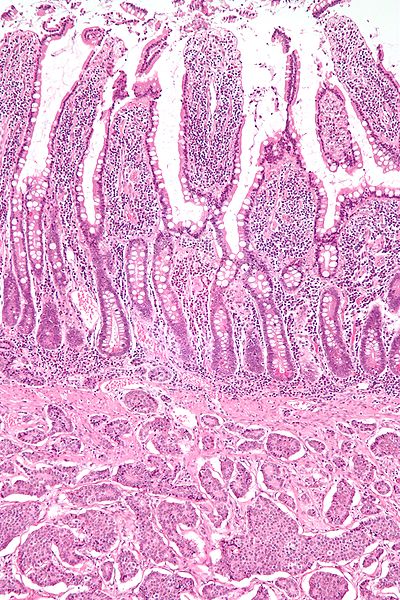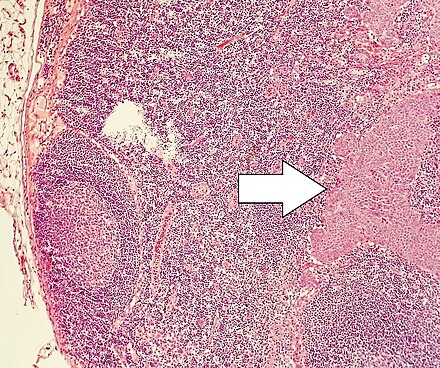Neuroendocrine Tumours
Neuroendocrine tumours (NETs) are neoplasms arising from cells of the endocrine and nervous systems. They commonly occur in the intestine, pancreas, and lungs but can be found throughout the body. These tumours share histological features, secretory granules, and often produce hormones.

Classification
The World Health Organisation (WHO) classifies NETs into three categories based on tumour grade rather than anatomical origin: well-differentiated NETs, well-differentiated neuroendocrine carcinomas, and poorly differentiated neuroendocrine carcinomas. This classification considers factors like tumour size, lymphovascular invasion, mitotic count, Ki-67 index, and metastatic presence. NETs of the gastrointestinal tract, pancreas, upper aerodigestive tract, and salivary glands are graded into three tiers based on proliferation rates.
Signs and Symptoms
Gastroenteropancreatic
NETs within the gastroenteropancreatic category include those of gastrointestinal origin and pancreatic origin. Carcinoid tumours are the most common, often affecting the small bowel and appendix. Symptoms may include flushing, diarrhoea, asthma, congestive heart failure, abdominal cramping, peripheral oedema, and heart palpitations. Pancreatic neuroendocrine tumours (PanNETs) may be nonfunctional or functional, secreting hormones like insulin or glucagon, leading to clinical syndromes.
Other
NETs can also arise in the lung, thymus, and parathyroid. They may cause symptoms like airway obstruction, pneumonia, pleurisy, difficulty breathing, cough, hemoptysis, and Cushing's syndrome. Familial syndromes like multiple endocrine neoplasia types 1 and 2, von Hippel-Lindau disease, and neurofibromatosis type 1 are associated with NETs.
Diagnosis
Markers
Symptoms from secreted hormones may prompt measurement of hormones in the blood or associated urinary products. Important markers include chromogranin A, urine 5-hydroxyindoleacetic acid, neuron-specific enolase, and synaptophysin.

Imaging
CT scans, MRIs, sonography, and endoscopy (including endoscopic ultrasound) are commonly used for morphological imaging. Advances in nuclear medicine allow for somatostatin receptor scintigraphy using octreotide and positron emission tomography (PET) with Gallium-68 for higher resolution imaging.
Histopathology
NETs show common phenotypic characteristics, including immunoreactivity for neuroendocrine markers. Typical histological features include small, yellow or tan masses located submucosally, often with a desmoplastic reaction.


Treatment
Surgery
Surgery is often a key treatment, even when curative surgery is not possible. It may help relieve symptoms and extend lifespan. Cholecystectomy is recommended if long-term somatostatin analogue treatment is considered.
Symptomatic Relief
Somatostatin analogues alleviate symptoms by blocking hormone release. These medications may also stabilise or shrink tumours. The PROMID and CLARINET studies have demonstrated the effectiveness of somatostatin analogues like octreotide and lanreotide in stabilising tumour growth.
Chemotherapy
Interferon and chemotherapy agents like everolimus and sunitinib are used in treating PanNETs. Poorly differentiated NETs may respond better to chemotherapy combinations.
Radionuclide Therapy
Peptide receptor radionuclide therapy (PRRT) uses radiolabelled hormones to target tumour cells, delivering targeted radiation with minimal side effects.
Hepatic Artery Treatments
Hepatic artery embolisation, chemoembolisation, and selective internal radiation therapy are used to treat liver metastases by occluding blood flow to tumours or delivering targeted radiation.

Self-assessment MCQs (single best answer)
Neuroendocrine tumours (NETs) most commonly occur in which of the following locations?
The World Health Organisation (WHO) classifies NETs based on which of the following criteria?
Which of the following is a common symptom of carcinoid tumours in the gastroenteropancreatic category?
Which marker is commonly measured to help diagnose NETs?
What imaging modality is commonly used for higher resolution imaging of NETs involving somatostatin receptors?
Which histopathological feature is typical of neuroendocrine tumours?
Which treatment is often recommended if long-term somatostatin analogue treatment is considered?
Which therapy uses radiolabelled hormones to target tumour cells in NETs?
Which of the following is NOT a common location for NETs to arise?
Which familial syndrome is associated with the development of NETs?
Dentaljuce
Dentaljuce provides Enhanced Continuing Professional Development (CPD) with GDC-approved Certificates for dental professionals worldwide.
Founded in 2009 by the award-winning Masters team from the School of Dentistry at the University of Birmingham, Dentaljuce has established itself as the leading platform for online CPD.
With over 100 high-quality online courses available for a single annual membership fee, Dentaljuce offers comprehensive e-learning designed for busy dental professionals.
The courses cover a complete range of topics, from clinical skills to patient communication, and are suitable for dentists, nurses, hygienists, therapists, students, and practice managers.
Dentaljuce features Dr. Aiden, a dentally trained AI-powered personal tutor available 24/7 to assist with queries and provide guidance through complex topics, enhancing the learning experience.
Check out our range of courses, or sign up now!


